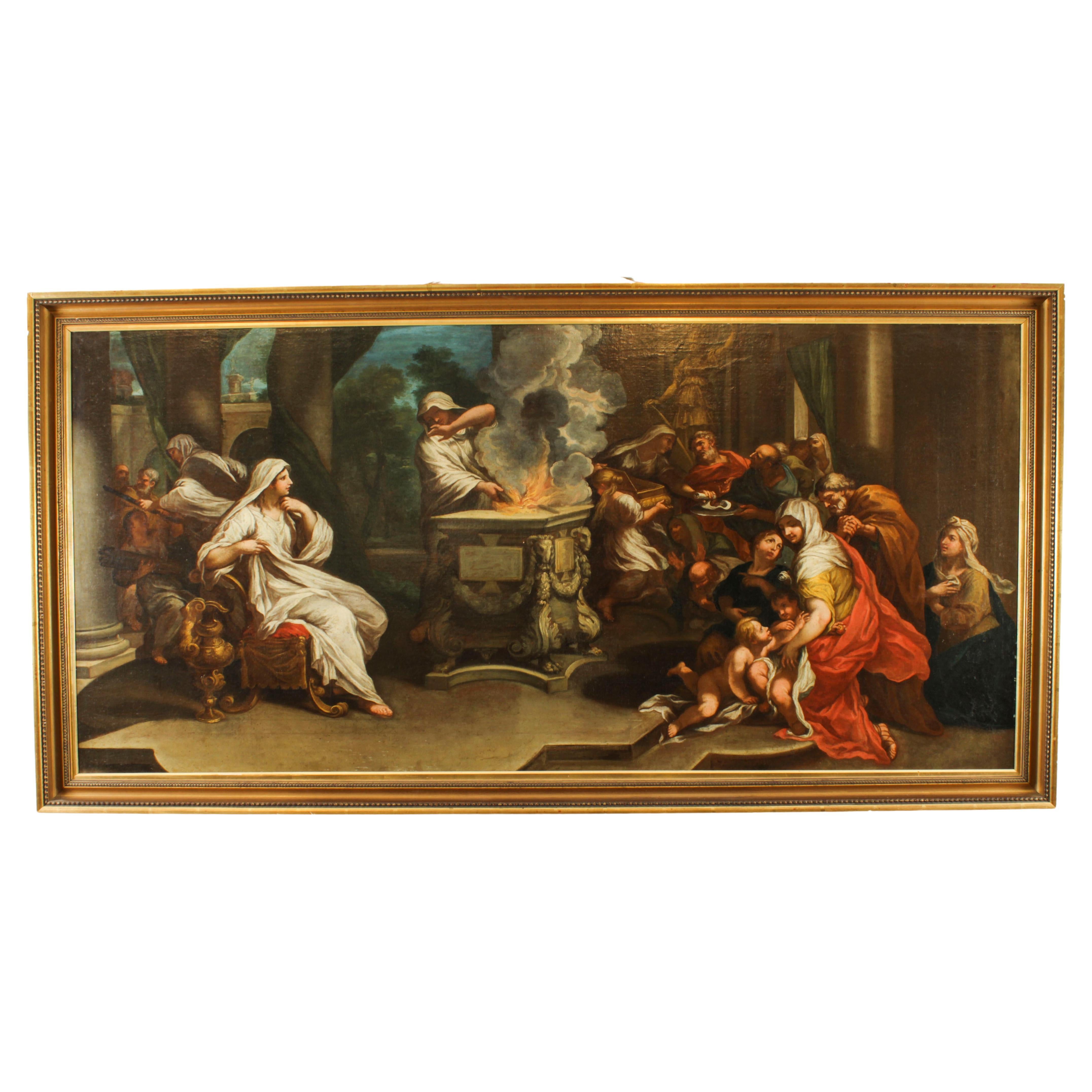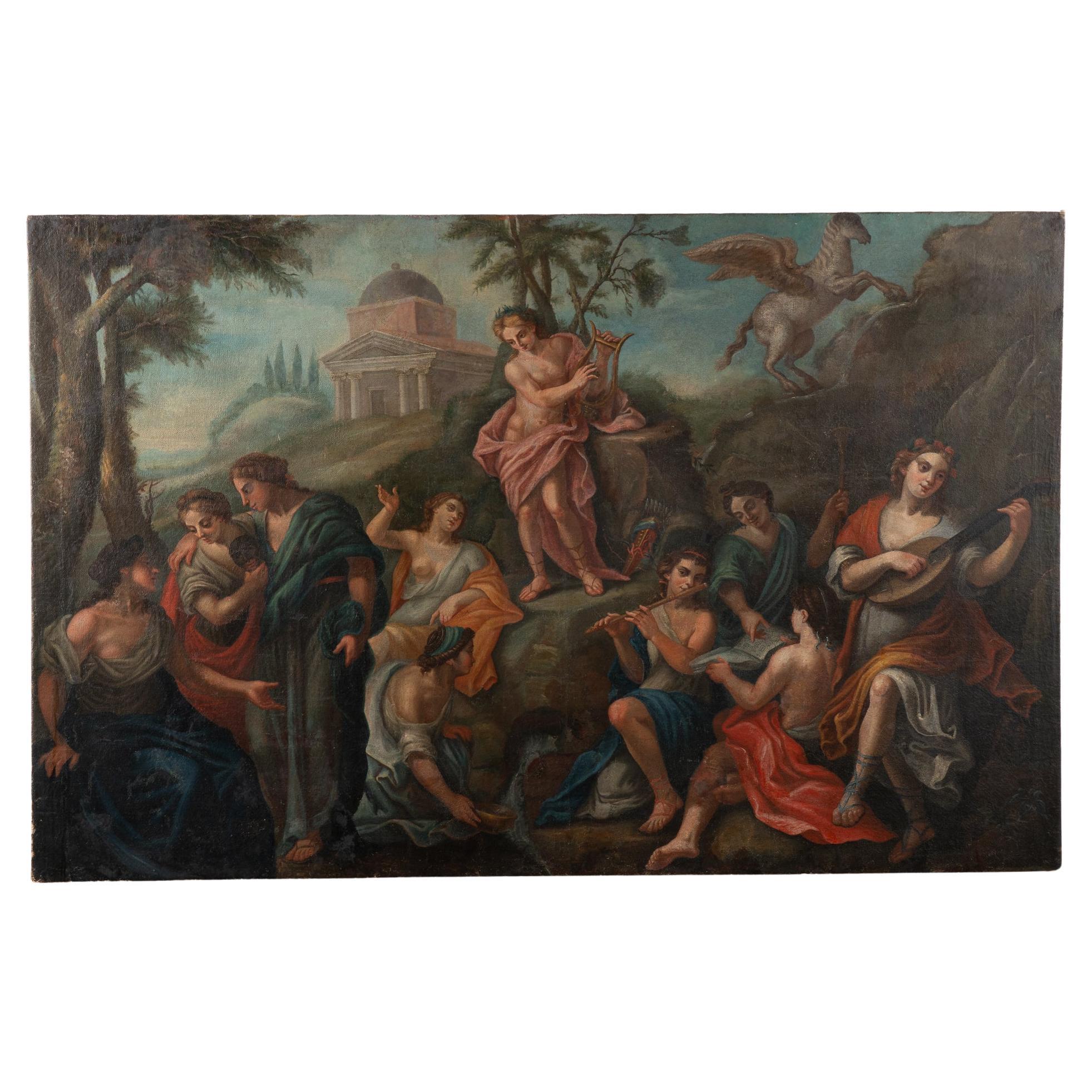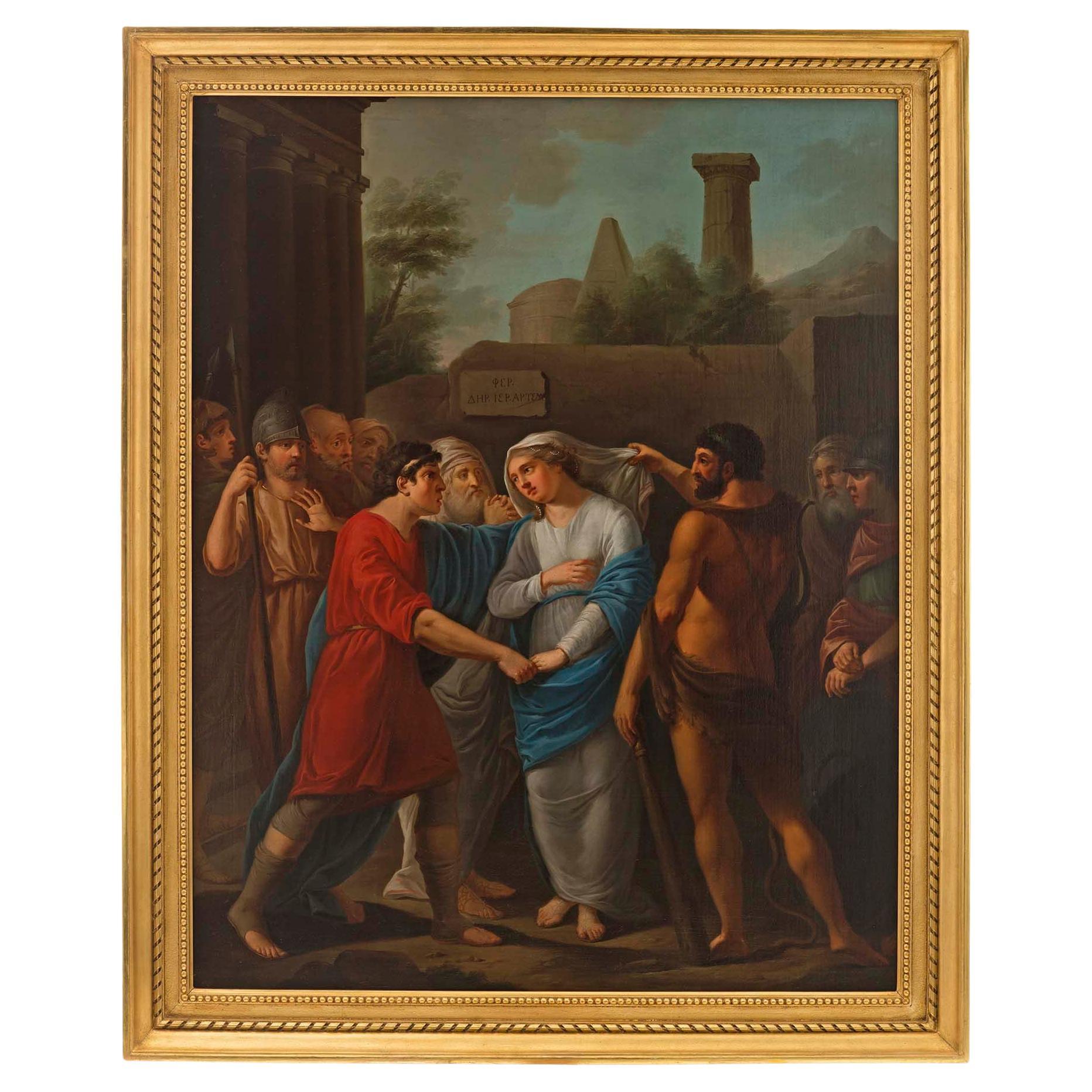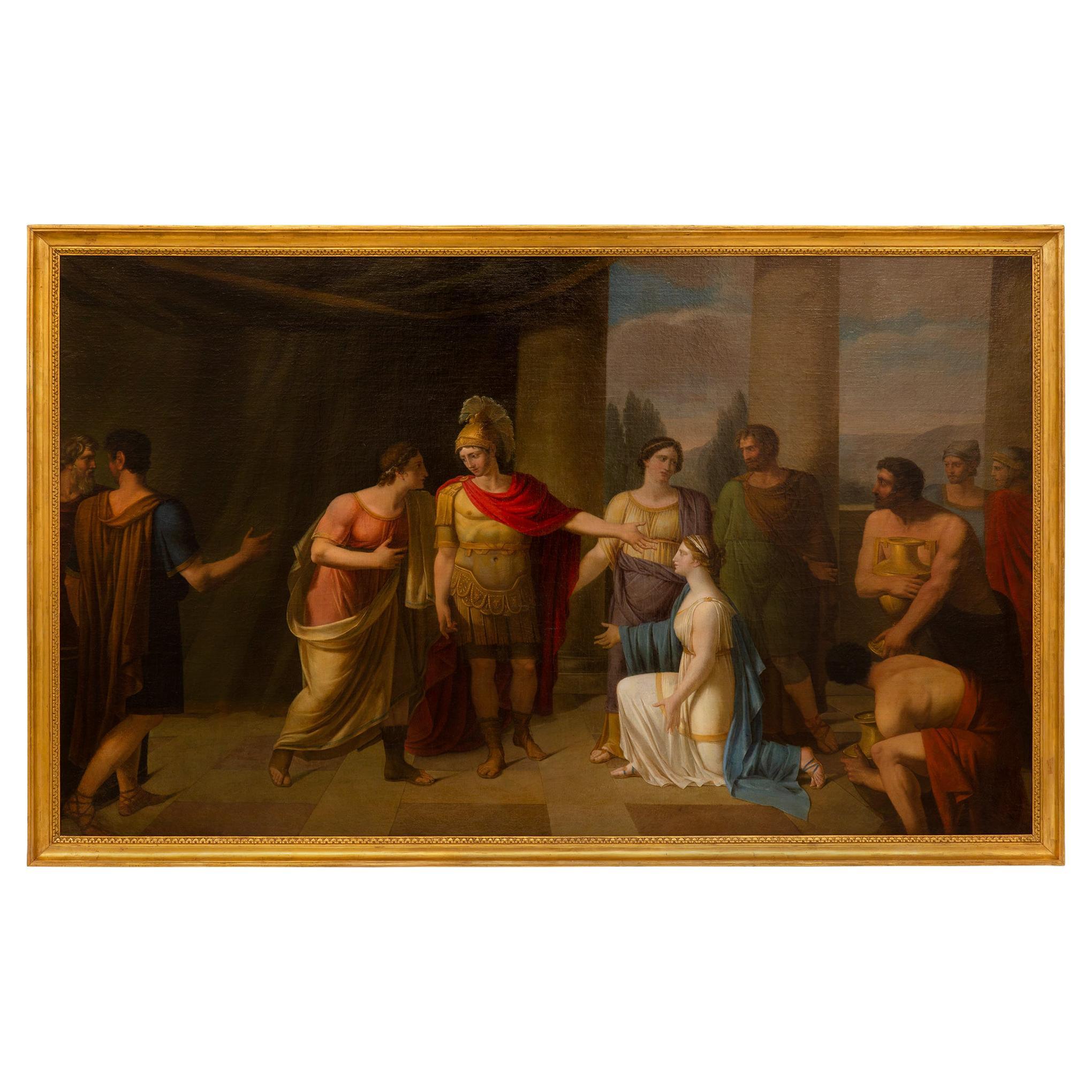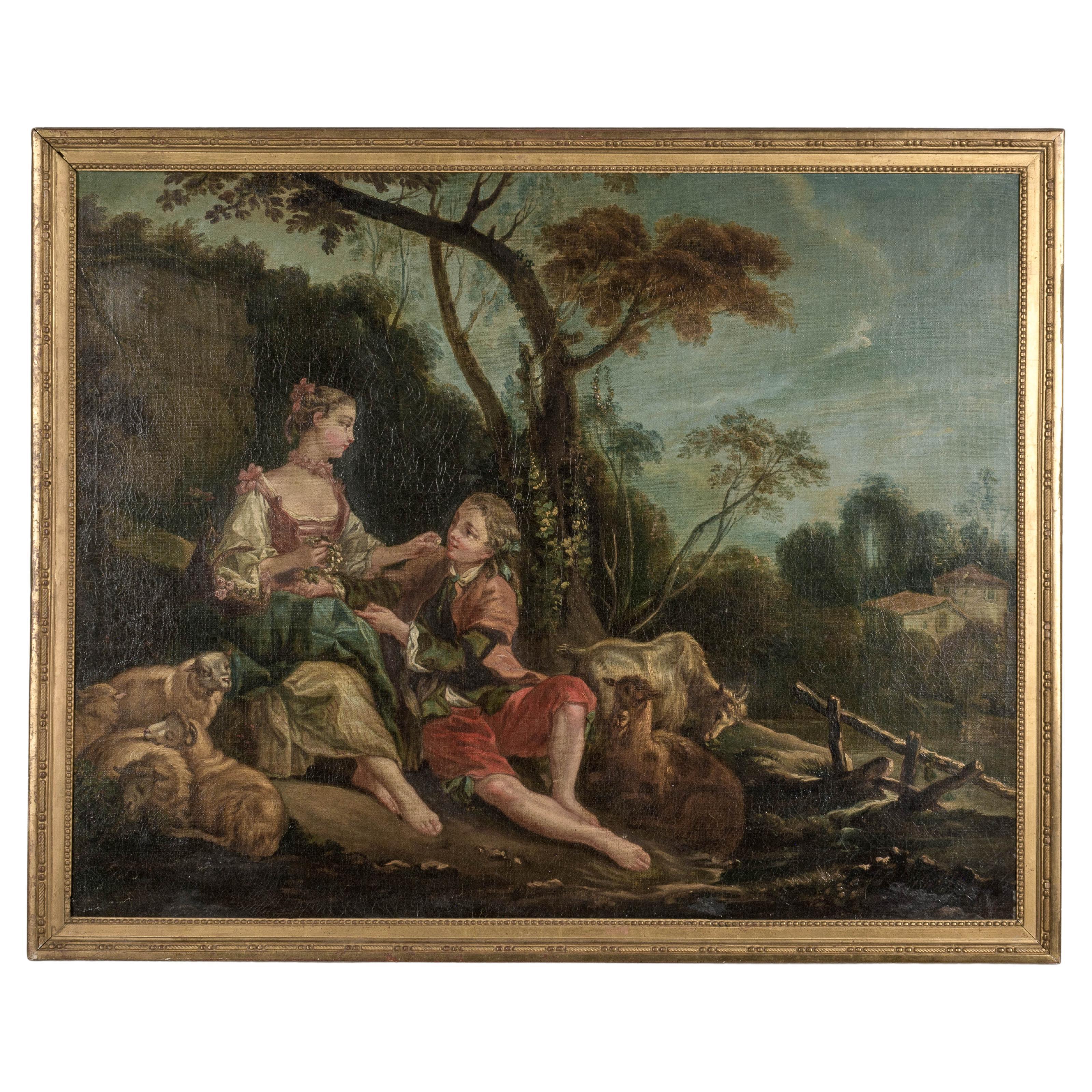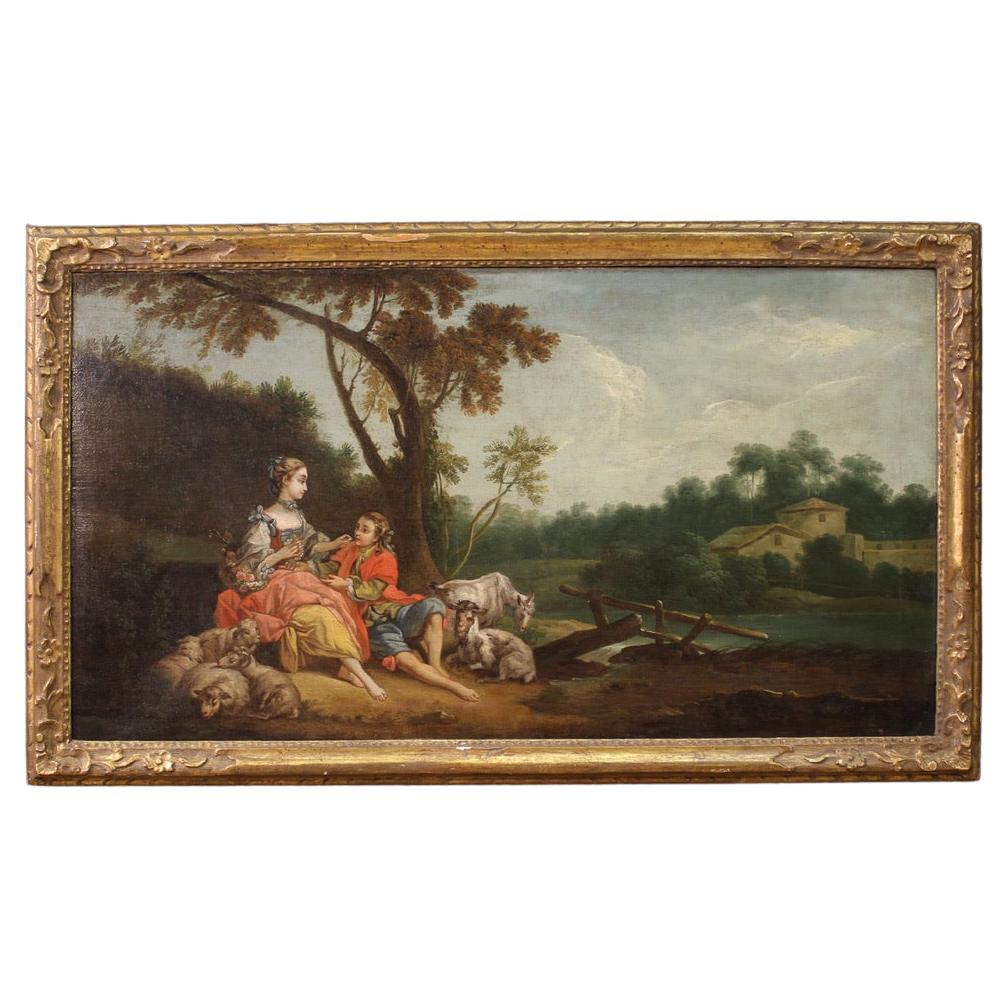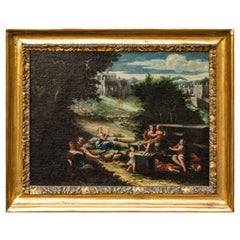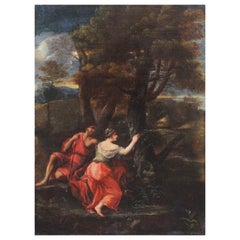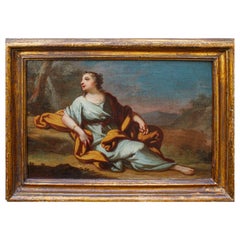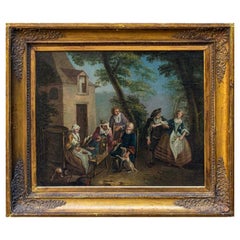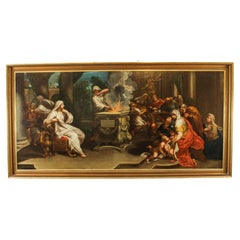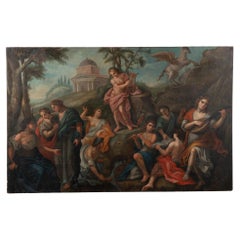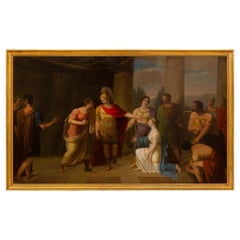Items Similar to 18th Century The Sacrifice of Iphigenia Roma School Painting Oil on Canvas
Want more images or videos?
Request additional images or videos from the seller
1 of 14
18th Century The Sacrifice of Iphigenia Roma School Painting Oil on Canvas
$5,270.06
£3,905.40
€4,400
CA$7,194.63
A$8,003.73
CHF 4,195.65
MX$97,803.60
NOK 53,426.42
SEK 50,293.59
DKK 33,501.21
Shipping
Retrieving quote...The 1stDibs Promise:
Authenticity Guarantee,
Money-Back Guarantee,
24-Hour Cancellation
About the Item
Roman school, 18th century
The Sacrifice of Iphigenia
Oil on canvas, Measures: 50 x 64.5 cm
The canvas depicts The Sacrifice of Iphigenia, a theme reported by numerous sources, including the Greek tragedies Iphigenia in Aulis by Euripides and Agamemnon by Aeschylus, as well as in Ovid's Metamorphoses. The myth tells how the Greeks, under the command of Agamemnon, gathered at the city of Aulis, in Boeotia, from which they then set sail for Troy. The persistent calm of the winds, however, prevents the Greek ships from taking to the sea and the forced stay of the armies in the city favors the spread of an epidemic. Discontent runs rampant and Agamemnon's authority falters. The king then questions the soothsayer Calcante to get some insight into what to do. The latter reveals to him that the difficult situation is the result of Artemis' anger towards Agamemnon himself, guilty of killing, during a hunt, a doe dear to the goddess. The only way to overcome the impasse - continues Calcante - is to sacrifice to Artemis Iphigenia, daughter of Agamemnon. The chief of the Greeks accepts and makes sure that the girl, accompanied by her mother Clytemnestra, reaches Boeotia: to induce mother and daughter to travel Agamemnon, lying, lets them know that Achilles has asked Iphigenia in marriage. Upon the arrival of Iphigenia in Boeotia, Agamemnon's deception is soon revealed, but the girl nevertheless agrees to sacrifice herself to allow the Greek army to reach Troy. he lets them know that Achilles has asked for Iphigenia in marriage. Upon the arrival of Iphigenia in Boeotia, Agamemnon's deception is soon revealed, but the girl nevertheless agrees to sacrifice herself to allow the Greek army to reach Troy. he lets them know that Achilles has asked for Iphigenia in marriage. Upon the arrival of Iphigenia in Boeotia, Agamemnon's deception is soon revealed, but the girl nevertheless agrees to sacrifice herself to allow the Greek army to reach Troy.
Our canvas, the work of a Roman Neoclassical painter, is taken from an engraving and a painting by the seventeenth-century painter Pietro Testa (Lucca, 1612 - Rome, 1650). As can be seen in the inscription contained in the first edition of the engraving (later eliminated), the print with the sacrifice of Iphigenia was dedicated by Pietro Testa to Mario Albrizzi, ecclesiastical holder of the office of referendum of the Two Signatures, judicial body of the pontifical administration. The complex dedication to the high prelate contains an eulogy to the purity of the design which is sometimes corrupted by the inadequate use of color. Mentioned by Passeri as one of the highest proofs of the Testa in the field, the engraving (as you can read on the step of the base of the altar) was printed in the printing house set up by Giovanni Giacomo de Rossi in Rome, in via della Pace. The print is signed with the monogram used by the artist (which superimposes a P, a T and an L, Petrus Testa Lucensis, ie Lucca) followed by the words pinx. [It] and sculp. [Sit]. The canvas that Testa derived from it is now kept at the Galleria Spada in Rome.
- Dimensions:Height: 19.69 in (50 cm)Width: 25.4 in (64.5 cm)Depth: 1.58 in (4 cm)
- Materials and Techniques:
- Place of Origin:
- Period:
- Date of Manufacture:18th Century
- Condition:Refinished. Wear consistent with age and use. The painting has been cleaned.
- Seller Location:Milan, IT
- Reference Number:1stDibs: LU5918226733962
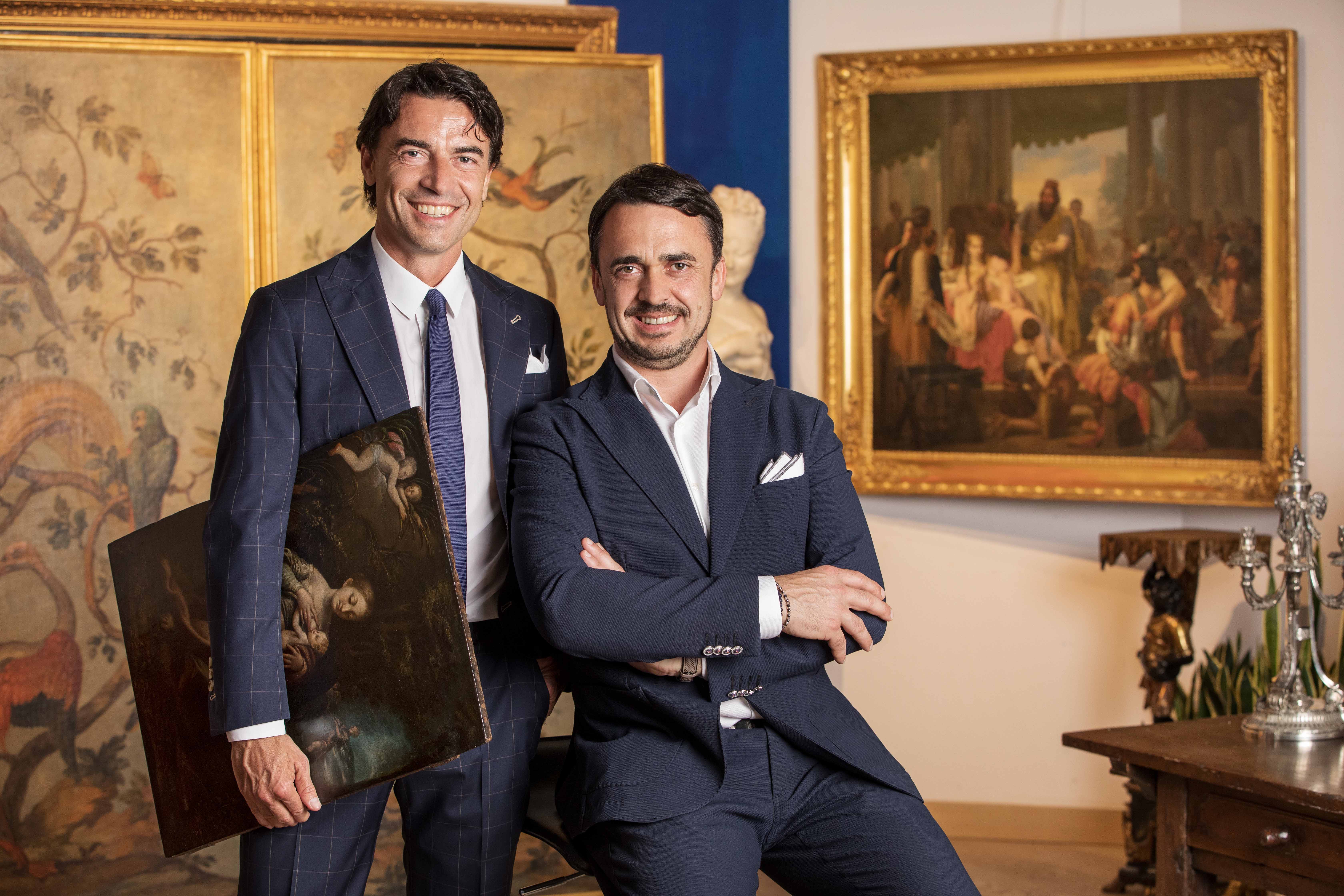
About the Seller
5.0
Vetted Professional Seller
Every seller passes strict standards for authenticity and reliability
Established in 2000
1stDibs seller since 2021
30 sales on 1stDibs
- ShippingRetrieving quote...Shipping from: Milan, Italy
- Return Policy
Authenticity Guarantee
In the unlikely event there’s an issue with an item’s authenticity, contact us within 1 year for a full refund. DetailsMoney-Back Guarantee
If your item is not as described, is damaged in transit, or does not arrive, contact us within 7 days for a full refund. Details24-Hour Cancellation
You have a 24-hour grace period in which to reconsider your purchase, with no questions asked.Vetted Professional Sellers
Our world-class sellers must adhere to strict standards for service and quality, maintaining the integrity of our listings.Price-Match Guarantee
If you find that a seller listed the same item for a lower price elsewhere, we’ll match it.Trusted Global Delivery
Our best-in-class carrier network provides specialized shipping options worldwide, including custom delivery.More From This Seller
View All17th Century Rural Landscape with Gallant Scenes Painting Oil on Canvas
Located in Milan, IT
17th century, Emilian school
Rural landscape with gallant scenes
Oil on canvas, 37 x 47.5 cm
With frame 61 x 50.5 cm
The bucolic amenity of the present is reflected in the joyful gallant scenes that dot its surface. The locus amoenus described reflects on the more traditional inflection of Arcadia, which in the literary transfiguration was the scenario par excellence of the most carefree pastoral life and out of this world; the painting is therefore a forerunner of what was professed by the actual poetic academy of Arcadia which was established in Rome in 1690, but enthusiastically testifies to the feverish invitations to its acceptance, then widespread in the most avant-garde cultural salons throughout Italy. First Theocritus and Virgil later had awakened with Idilli and Bucoliche that capacity typical of the natural world to allow an escape from reality; the contemplation of perfect natural fruits that followed would have evoked in the spirits of dreaming men back to origins. The bucolic landscape was able to positively give a rhythm to material life, and constituted the concretization of a place devoid of incivility and ugliness, where only dreams, wild music and homages to fruitful nature were allowed.
In the present painting widespread figures of shepherd children trace the same intent to the sublimation of earthly life, gathered in pairs, while children on the model of the ancient cherubs cheer the field with flowers and petals. The games of these and the sweet affections of the other characters are rendered through liquid and vibrant brushstrokes, flickering with a white light that opposes the dark shadow of the undergrowth. In the distance, the sky tapers with a silvery and flat brushstroke, while the vertical development of the promoters with architectures helps to introject a bright beam of light into the grassy clearing. The foliage and the turf of the landscape piece are rendered through a digital brushstroke, betraying the Italian brand of the present, influenced at the same time by the seventeenth-century European influences that then conveyed to the capital. The evocative culture of the city attracted many artists from the city of Bologna, from the Italian north but also from the territories beyond the Alps, such as Claude Lorrain and Nicolas Poussin. The historical-artistic heritage of the Italian pastoral scenes was thus able to fill up with the more functional and particular formalisms of the charms coming from elsewhere, such as the expressive tremor of the present, similar to the contemporary French lexicon.
The typological restitution from pastoral idyll, in accordance with the intrinsic stylistic qualities of the work, allows us to specify the solid belonging of the present to the Italian hand, similarly to what was then emerging in the pictorial sphere within the Emilian school. In this regard, we should recall the latent influences of two decisive foreign landscape painters who passed through the Emilian belt, such as Claude Lorrain (1600-1682) and Nicolas Poussin (1594-1665); before them, Giovanni Battista Viola...
Category
Antique 17th Century Italian Paintings
Materials
Canvas
17th Century Angelica and Medoro Painted Oil on Canvas Roman School
Located in Milan, IT
Roman School, 17th century
Angelica and Medoro engrave their names on the bark of a tree
Oil on canvas, 65 x 48.5 cm
The canvas depicts one of the most famous episodes of O...
Category
Antique 17th Century Italian Paintings
Materials
Canvas
18th Century Lying Female Figure Painting by Giovanni Domenico Molinari
Located in Milan, IT
Giovanni Domenico Molinari (Caresana, 1721 - Turin, 1793)
Lying Female figure
Oil on canvas, cm 46 x. 31 - With frame, cm 56 x 42
The present painting is connected by style and treated subject, in this case a young girl lying in an idyllic landscape, to the production of small pictures of pastoral subject of the Piedmontese painter Giovanni Domenico Molinari (Caresana, 1721 - Turin, 1793).
Molinare was born in Caresana (Vercelli) on 19 July 1721 but after losing both his parents he moved to Turin. Here he became, from 1736, a pupil of the Academy of Drawing founded by the painter Claudio Francesco Beaumont (Turin, 4 July 1694 - Turin, 21 June 1766) where he remained as a pensioner until December 1755. Molinari was immediately engaged in the translation of the master’s sketches on cardboard used for the Regia manufacture of tapestries. His early success on the Turin art scene is confirmed by the fact that he joined the Compagnia di San Luca in 1756.
In 1751 he married Margherita Peiroleri, whose brothers Pietro (engraver) and Nicolò (painter) also attended the school. Remained widower count two other marriages first with Lucrezia Elisabetta Burzio and then in 1770 with Domenica Maria Ferrero.
On the death of the master in 1766 Molinari, considered by his contemporaries to be the most faithful interpreter of the master and for his elegant and Arcadian style, which clearly interprets the aesthetic taste of the court, was called to finish the works that remained unfinished, such as the altarpiece for the church of Santa Maria della Scala in Moncalieri depicting the Assumption venerated by Blessed Bernard of Baden and Saint Anthony. Molinari was also well praised by critics and Abbot Lanzi highlighted the quality of the production of historical and mythological subject for the rigorous post-marattesco classicism.
In Turin he worked for Vittorio Amedeo III of Savoy as a portrait painter, executing for him eleven canvases (between 1774 and 1775), but, since 1745, he also supplied tapestry cartoons to the local Fabbrica, of which, in 1766, he became director.
The production of paintings of sacred subjects is also lively, especially used in the decoration of the churches of the capital as the Assumption for the Hotel of Virtue and San Pietro Regalado and San Benedetto il Moro for Santa Maria degli Angeli ( Torino) He also painted tempera and oil cartoons for the same church, on the occasion of the beatification of Pacifico da San Severino (1787) and, for that of San Francesco di Paola, when Gaspare de Bono...
Category
Antique 18th Century Italian Paintings
Materials
Canvas
18th Century Scene with Spinner Piedmontese school Painting Oil on Canvas
Located in Milan, IT
18th century, Piedmontese, School
Scene with spinner
Measures: Oil on canvas, 50 x 60 cm
Frame 70 x 80 cm.
Category
Antique 18th Century Italian Paintings
Materials
Canvas
17th Century St. John Baptist Florentine School Painting Oil on Canvas
Located in Milan, IT
Florentine school, 17th century
St. John Baptist
Oil on canvas, diameter cm 20 - with frame diameter 30
In this small round-format canvas, St. J...
Category
Antique 17th Century Italian Paintings
Materials
Canvas
17th Century Rest on The Flight to Egypt Emilian school Painting Oil on Canvas
Located in Milan, IT
17th century, Emilian school
Rest on the flight to Egypt
Oil on canvas, 42 x 33 cm
Frame 65 x 55 cm
The present Holy Family, ...
Category
Antique 17th Century Italian Paintings
Materials
Canvas
You May Also Like
Antique Oil Painting "Sacrifice to Minerva" Odoardo Vicinelli Letterfourie 18thC
Located in London, GB
A large antique oil on canvas painting entitled "Sacrifice to Minerva", circle of Francesco Solimena, attributed to Odoardo Vicinelli, dating from the mid 18th Century.
The painting depicts a man standing, behind an altar, shielding himself from a kindling fire. To the left of the altar is seated Minerva, in classical flowing white robes, surrounded by a crowd of people.
Francesco Solimena (4 October 1657 – 3 April 1747) was a prolific Italian painter of the Baroque era, one of an established family of painters and draughtsmen.
Verso: Title, describtion, inventory marks and later restoration stamp: Aitken Dott & Son, Edinburgh 15 July 1970.
Also bears an inscription attributing the painting to Odoardo Vicinelli:
Odoardo Vicinelli, scholar of Giovanni Maria Morandi, flourished about 1750
an excellent master of the Venetian and Roman Schools,
Provenance:
Formerly at Letterfourie, Morayshire, and by descent, through the Gordon family
Letterfourie House is a Georgian house in Moray Scotland, built by Robert Adam and completed in 1773 for Clan Gordon...
Category
Antique 1750s Italian Paintings
Materials
Canvas
Original Oil On Canvas Large Allegorical Painting, Italian School 1750-1800
Located in Round Top, TX
Original large oil on canvas allegorical scene from Italy with vivid colors. Note the Pegasus, ten figures, and use of lute, lyre and flute.
Condition: Age related craquelure throug...
Category
Antique 18th Century Italian Paintings
Materials
Canvas, Wood, Paint
German 18th Century Neoclassical Themed Oil on Canvas
Located in West Palm Beach, FL
A superb quality German 18th century Neo-classical themed oil on canvas by Johann Dominicus Fiorillo. The painting depicts a courtship in the town square with townspeople looking on. The maiden is draped in modest classical dress and the young man in a vibrant red garment, holds her hand. Wonderful execution and detail throughout. Johann Dominicus Fiorillo (Hamburg 1748 - 1821) was a German painter and historian of art. Fiorillo, a son of Italian...
Category
Antique 18th Century German Neoclassical Paintings
Materials
Canvas, Giltwood
Continental 19th Century Neo-Classical St. Oil on Canvas Painting
Located in West Palm Beach, FL
An impressive and large scale Continental 19th century Neo-Classical st. oil on canvas painting. The painting is set within its original giltwood framed with a fine mottled design an...
Category
Antique 19th Century Unknown Neoclassical Paintings
Materials
Canvas, Giltwood
18th Century French Baroque Oil Painting
Located in Winter Park, FL
A late 18th century French painting depicting a romantic couple in a pastoral setting. Oil on canvas. Unsigned. Original gilded wood frame. Small repair to canvas in the upper left c...
Category
Antique Late 18th Century French Baroque Paintings
Materials
Giltwood, Paint, Canvas
18th Century Oil on Canvas French Antique Rococo Gallant Scene Painting, 1750
Located in Vicoforte, Piedmont
Splendid French painting from the 18th century. Oil on canvas artwork depicting a wonderful rural scene in the Rococo style with young people and grazing animals, of remarkable picto...
Category
Antique 1750s French Paintings
Materials
Canvas
